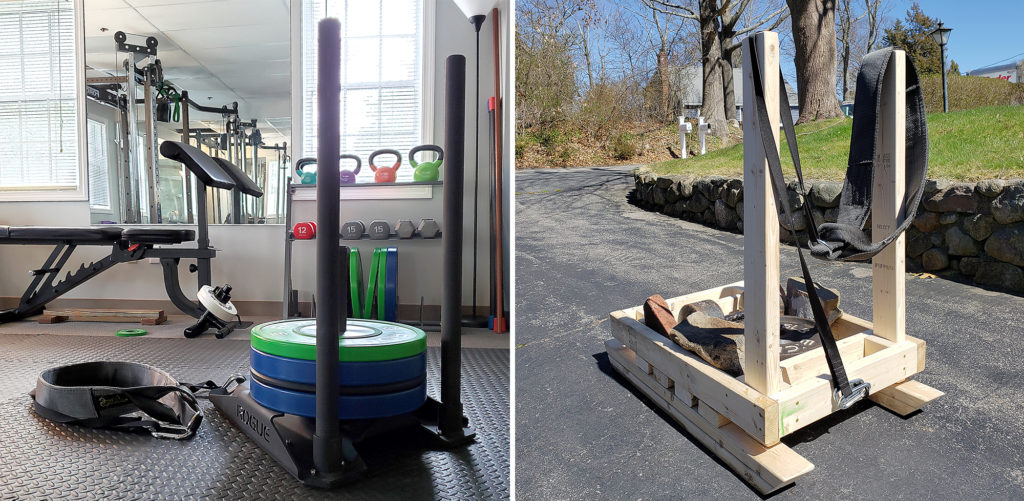If you’ve ever had nagging knee or ankle pain, please read on. If you’ve ever had surgery and/or therapy for a knee or ankle injury and still have nagging pain, please read on. If you do not yet have nagging knee or ankle pain but wish to “bulletproof” these areas so that you may be much less likely to experience debilitating pain, please read on.
Disclaimer alert: I am not a medical doctor and therefore cannot and do not give out medical advice. I can, however, pass along revolutionary discoveries, ingenious ideas and logical information that has not yet been written into the medical textbooks.
One of these said amazing concepts has been brought to us by no other than master dot-connector himself, Ben Patrick. Although there are several life changing exercises promoted by Ben, we’ll focus on the most important one here, sledding.
More specifically, we’re talking about the therapeutic pushing and pulling of some form of ground-based “sled” mostly in the reverse direction, i.e., backwards. This is not your grandpa’s hardcore football sledding; this is something anyone can do with scalable effort and adjustable varieties.
Why is this concept so important for you and why is it so revolutionary? The short answer is that as we aged past the toddler years, most of us forgot how our ankle and knee joints were meant to be used. We stopped using them correctly, pain ensued, injuries may have worsened things, and we stopped using them further. This snow-balling situation ultimately ends in either surgery and/or chronic pain for most people, especially athletes.
In one form or another, our predicaments were further worsened by the 1978 Duke University study on knee compression. It’s a simple case of well-intentioned scientists collecting good data and applying it in terribly bad fashion. Simply put, they found that as the knee moves forward while squatting, the pressure at the knee increases. So, because pressure can be a bad thing sometimes, they insinuated that no one should ever allow their knees to go over their toes, period. Sigh.
This one study can account for the ruin of millions of people’s knees (and bodies indirectly) over the last 40 years. This poorly applied information was generously distributed by every doctor, physical therapist, strength coach and personal trainer since then, and is still widely promoted today.
Now for the good news. I am beyond grateful for Ben Patrick’s contribution to solving the puzzle of knee pain and ankle pain reversal, strengthening and bulletproofing. This is a guy who was the slowest player on his high school basketball team with chronic knee pain, three surgeries, addiction to pain killers and a 19-inch vertical jump. After he connected the dots and enacted his own rehab plan, he now lives pain free, dunks the ball with a 42-inch vertical, and lands into a full split if he wants to show off. He’s 6 foot 1 by the way, and super-fast now.
His list of dots starts with learning that as a part of Chinese culture, the elderly are taught to walk backwards to prevent cartilage break down and arthritis. A string of the best strength coaches in the world discovered that training the knees over the toes provided more strength at the knee and more safeguarding. Charles Poliquin, Keegan Smith and Louie Simmons all played their part. Louie noticed that Finnish lumberjacks had “off the charts” knee health and strength from dragging logs backwards day after day. This discovery led to the use of a fitness sled.
It sounds silly, but when you take a step backwards, your knee will actually be positioned way over your ankle and toes. It’s just natural (take a look if you can). When you add tension to the equation, you have a measurable stimulus to add safe compression to your ankles and knees to provide the necessary blood flow and synovial fluid for nutrient exchange and maximum joint rejuvenation. This simply does not happen with normal forward walking and ordinary gym exercises.
To reap the benefits of this type of exercise you’ll need some form of ground sled or cable/band system and a sled belt preferably. Good push/pull sleds run between $300 to $600 not including the belt, strap and weights. I built my home-gym sled for around $50 with some scrap 2×4’s, deck screws and an eye bolt. The great thing about therapeutic sled exercises is that you don’t really need much weight. All you need is “enough” resistance to safely challenge the joints and a lot of that depends on the friction between the sled and the ground surface. When working with cable systems or bands, you’ll need even less.
Therapeutic sled instruction is included in all my Full Spectrum Personal Training programs but if you want to check it out now, please visit Ben Patrick’s website and/or channel. He is a brave and caring person who has pioneered possibly the greatest shift in fitness health and performance that we may ever see.
As always, I am here to help with all your weight loss, fitness, and wellness goals. Please do not hesitate to reach out for a consult as I look forward to hearing from you! 😊
